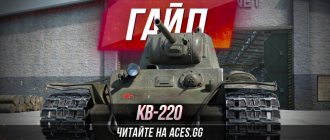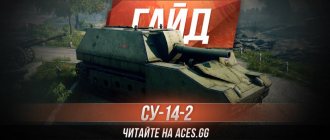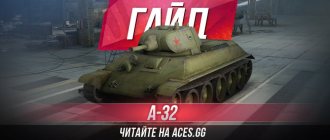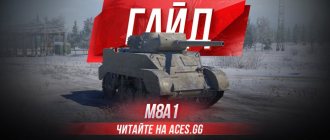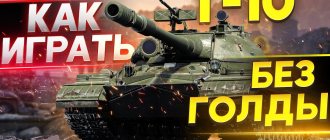Maus is a Tier 10 German heavy tank, a real mobile fortress. Over its long history in the World of Tanks game, the tank was repeatedly destroyed, nerfed, and destroyed again. He went through many ups and downs in the audience, but he always had fans. Let's take a closer look at how Maus feels in random games in 2022, how its gameplay has changed, and whether it can now compete with new heavy tanks.
Combat effectiveness
When switching to Maus from any other vehicle, especially light ones, you can safely forget about quickly moving across the entire map. You need to pay maximum attention to planning your route in advance.
For all its clumsiness, the “Mouse” is equally effective in both attack and defensive positions. Therefore, we highlight two main tactics for playing the German giant:
- base defense, even alone against several opponents, since the safety margin and armor are enough to stop any enemy;
- “human shield” during the offensive, which will cover nimble allies with its carcass.
Mouse still needs to be careful. It can easily be stopped by a tank destroyer of the same level ten. If the “self-propelled gun” manages to determine the position of the “Mouse” and hit it.
Advantages and disadvantages
reliable armor
strength of 3000 units, the highest among equipment
impressive one-time damage
large mass, allowing you to ram opponents without serious consequences for yourself
low fire hazard
space for large ammunition on board
the ability to stabilize the gun in motion and when turning the turret at good gun declination angles
significant damage per minute
low speed
clumsiness
impressive size
slow rotation of the tower
How to play Maus
Mouse is a breakthrough tank, a leader who leads the team. Excellent armor contributes to “pushing” directions; there are few people willing to go 1v1 against such a steel monster. When the opposite situation arises, being in the minority and without sufficient support, it is better to defend the direction. If you take a position correctly and choose cover from artillery, then with proper tanking, Mouse will be able to hold back the enemy pressure for a long time.
For successful tanking, you first need to hide the NLD. If this is not possible, you need to turn out the “diamond”. To protect the cheeks of the turret, after each shot you need to turn the turret away from the shooting enemy, exposing the corners to him. This firefight can continue until Mouse receives support from allies or is surrounded by the enemy team.
Mouse should be wary of tank destroyers due to high penetration and artillery, which will cause a lot of inconvenience with landmines. At close range, medium tanks can drive into the rear and shoot the tank point-blank.
In order to extend your life on the battlefield, you need to remember a few basic rules for Mouse:
- Avoid long journeys without shelter, because if Mouse is exposed on the way, he will most likely receive damage;
- Wherever you are, try to find cover so as not to become an easy target for artillerymen;
- Despite his armor, Mouse needs support and cover, because his weak dynamics allow CT and LT to spin him. Therefore, always pay attention to the map.
Equipment, equipment and ammunition
Depending on the chosen tactics, the Mouse branch in World of Tanks implies several options for the order of pumping:
- First, we install a rammer to reduce reload time, then we acquire a vertical aiming stabilizer (there will be less dispersion on the move, and complete convergence will be faster) and improved ventilation, which has a positive effect on all performance characteristics.
- The first two pieces of equipment are the same as in the previous paragraph, and then we spend money on anti-fragmentation lining, which reduces damage during a ramming by the enemy and a landmine explosion, and also reduces the chances of concussion of the crew.
- Rammer – Improved ventilation – Anti-fragmentation lining. This set of equipment will turn the “Mouse” into a real battle fortress.
From equipment we stop at:
- chocolate;
- large first aid kit;
- large repair kit.
The ammunition load should be filled almost to the maximum with armor-piercing shells, diluting it slightly with sub-caliber shells if you need to stop armored opponents. In case of destruction of wounded opponents, it would not hurt to take a couple of high-explosive fragmentation ammunition with you.
Comparison of Maus with other tier 10 heavy tanks
| Characteristics | Maus (Germany) | E100 (Germany) | IS-7 (USSR) | T30 (USA) | AMX 50B (France) |
| Strength | 2800 | 2400 | 2150 | 2200 | 2100 |
| Weight (t) | 188.98 | 129.69 | 68.19 | 64.45 | 62.21 |
| Engine power (hp) | 1750 | 1200 | 1050 | 860 | 1200 |
| Maximum speed (km/h) | 20 | 30 | 50 | 35 | 65 |
| Turning speed (deg/sec) | 15 | 20 | 28 | 28 | 32 |
| Hull armor (front/sides/stern in mm) | 200/185/160 | 200/130/150 | 150/150/70 | 102/76/51 | 170/30/30 |
| Turret armor (front/sides/rear in mm) | 220/210/210 | 240/150/150 | 240/185/94 | 279/127/102 | 100/50/30 |
| Basic projectile damage | 490/490/630 | 490/490/630 | 490/490/640 | 750/750/950 | 400/400/515 |
| Armor penetration with basic projectile (mm) | 246/311/65 | 246/311/65 | 260/303/68 | 276/320/90 | 267/351/65 |
| Gun rate (rounds/min) | 4.62 | 4.8 | 5 | 3.64 | 6.86 |
| Turret rotation speed (deg/sec) | 16 | 20 | 28 | 36 | 36 |
| Review (m) | 460 | 460 | 460 | 460 | 460 |
| Communication range (m) | 820 | 820 | 820 | 850 | 850 |
| Game tactics | Base defense, "Steel Wall" | Support tank | Breakthrough tank | Support tank | Assault tank, Sniper tank. |
Pros: • Excellent armor. • Accurate and powerful weapon. • The largest amount of health. • Weight 190 tons.
Cons: • Low speed (20 km/h). • Slow turret rotation. • Poor tilt angles. • Huge size (almost impossible to disguise). • A desirable target for artillery.
Video reviews
Maus - guide, guide on how to play the monster
Where to punch it?! Mouse showed CANCER where to spend the winter in World of Tanks!
27 THOUSAND TOTAL DAMAGE ON MAUS! STEEL MONSTER'S DREAM BATTLE WORLD OF TANKS!!!
Mouse penetration zones
Let's look at two examples:
- if you are on a top ST
- on a top TT.
In the first case. You should not shoot either at the lower armor plate or at the cap on the roof. You won't have enough armor penetration in this place.
If you see Mouse turned sideways towards you, the chances of breaking through greatly increase, we can only penetrate it into the rear armor and only at a right angle. It’s also worth shooting no more than 100 meters away, because if you shoot from a long distance the projectile greatly loses its armor penetration.
Well, the most problematic place on the Mouse is the characteristic “bump” in the center of the rear of the turret, which even the Soviet T 50-2 light tank can penetrate, not to mention our gun. This will help you a lot, because Mouse’s tower rotates slowly, but we are fast and the opportunity to drive behind Mouse’s back and spin, causing regular damage, increases.
We also penetrate the hull armor from the rear, but here the chances of penetrating the tank are much lower. We also regularly penetrate under Mouse's tower, causing good damage and getting a chance to break the tower's rotation equipment.
In the second case, if we play, say, on Mouse and meet the same enemy, which is very rare in random battles, and other tanks get in the way, but we’ll still consider this situation. If the enemy is facing you, then you should shoot at the lower armor plate, but only at a right angle we will consistently penetrate.
It is also worth mentioning the “cheeks” - these are the places on both sides of the gun mantlet. This is exactly the place where Mouse’s convex tower has a minimal angle towards us, which gives us the opportunity to break through.
If the tank is standing at an angle towards us, then a variety of factors begin to play here, such as “luck” and the “Great Belarusian Random” (GBR), because without them you will not be able to penetrate the Mouse. If the tank is standing at an angle, and the turret is looking at us, then it is worth working on the turret, namely on the “cheeks”. If the turret turns away, then just load the “gold” and work on the lower armor plate or into the hull of the part closest to us.
If the tank is facing you, then we can pierce it anywhere, both in the turret and in the hull, because the power of the “mouse” is in how to place it.
Historical reference
By the end of 1942, at the instigation of Hitler, several large companies, including Daimler-Benz, Krup and Siemens, began work on a well-protected and lethal machine. In 1944, with the help of Ferdinand Porsche, the first two prototypes of the Porsche Typ 205 project were born. But things did not come to widespread implementation. The project is being canceled due to a lack of production capacity after only a dozen tanks were released into mass production. Many historians believe that Maus could have influenced the course of history if he had gotten onto the production line at least a year earlier.
Story
At the height of World War II, Germany attempted to create a super-heavy “breakthrough tank.” Under such circumstances, the Maus project appeared in 1942. In general, it was originally supposed to be called “Mammoth,” which really suits it better, given its dimensions, but for the sake of secrecy, the name was changed to “Mouse.”
The desire to create a vehicle that was maximally protected from all sides was the reason that the tank exceeded the weight limit specified in the project. He was unable to move independently off-road, and his weight could not be supported by any bridge. The second problem was the quality of the armor. Already at the time of its production, Germany was experiencing a shortage of molybdenum. Therefore, the low-quality armor of the tank was not only better able to be penetrated by shells, but also split and cracked inside, threatening the lives of the crew. Given this quality of armor and its dimensions, the tank would become an easy target for artillery on the battlefield. The only advantage was its gun, the most powerful of all tanks of that period.
Taking into account the production costs and extremely dubious effectiveness in combat, the project was considered unprofitable and was closed. The only two prototypes produced were blown up as Soviet troops approached. Nevertheless, from the remains of tanks, Soviet engineers assembled one, which is now located in Kubinka among the exhibits of the museum of armored forces.
Making a shield for a costume
Guide to IS-4
Since the shield is considered a height shield, measure the child’s height from the floor to the upper edge of the chest. This will be the height of the craft. The width is taken by eye. The shield should cover the child completely, but no more, so that it is comfortable to carry and play its role at a holiday or during a theatrical performance.
Before cutting out the required shape, draw it on the back of the cardboard with a simple pencil, taking all measurements with a long ruler
Pay special attention to the corners, they must remain straight. When the rectangle is cut out, round the edges of the craft according to the template.
Next you need to paint the entire surface with red paint and allow time to dry. To prevent paint from staining your hands and the rest of the little legionnaire’s outfit, you can cover the outside with strips of transparent tape. Next, find the middle of the shield. There you need to place a round umbo. To do this, you need to cut off half a sphere from a plastic ball and glue the part, spreading the end part with hot glue.
It is interesting to add a golden edging around the entire perimeter of the craft, cut according to a template from glossy colored paper, to make it more similar to a real shield.
Hitler's Iron Caput
The leadership of the Third Reich first learned about super-heavy tanks in 1940, after the surrender of France and research into local developments on the topic (projects FCM F1 and ARL Tracteur C). Based on the design data, the Verkhmat leadership came to the conclusion that the Pz.Kpfw.VII heavy tank looked clearly outdated compared to its French competitors and it was necessary to make an even more powerful vehicle.
Work on the concept of a super-heavy tank began in 1941 under the personal supervision of Adolf Hitler. Several different design teams were involved. Hitler accelerated work on this class of tanks, since the Wehrmacht expected to see new Soviet heavy tanks at the front in the spring of 1943 - the Fuhrer needed a “breakthrough tank” with the thickest possible armor.
One of the original concepts One of the original concepts
Work specifically on the Mäuschen (“Mouse”) began on March 22, 1942, by the conglomerate (conceptual development), Daimler-Benz (power plant), Krupp (hull), Siemens (electrics), Skoda (suspension) ) and "Alkett" (final assembly).
It was initially planned that the weight of the tank would be from 100 to 120 tons, a 149-mm cannon with 100 rounds of ammunition and a barrel length of 37 calibers would be installed. The height will be 3.3 meters, width 3.45, length 10.62 meters.
This colossus had to be driven by a diesel engine that turned a generator - the tank moved with the help of a pair of electric motors.
Hitler approved this concept and said that "the new tank will become a mobile fortress"
, but demanded to strengthen the reservation. The length of the gun was supposed to increase to 60-70 calibers (9-10 meters). As you can imagine, all these changes meant more weight, which required an even more powerful power plant. The low driving performance of the super-tank was seen as the main problem.
Design research on the “Mouse” was carried out throughout 1942 - the turret and the location of the guns were revised twice (there should have been two of them), the armor of all hull elements was constantly reworked, the power plant was selected (in the end they decided to use a 12-cylinder 1000-horsepower diesel engine from Daimler-Benz and 18-cylinder 780-horsepower diesel from Porsche).
As engineers regularly returned to the concept drawing board, the weight of the “miracle weapon” steadily grew - 130, 150, and then 170 tons. But, despite the complexity of the design, the task was completed. Let's skip the approvals stage and look at the result.
Construction[edit]
"Mouse" is not a completely standard tank. The control compartment is located in the front part, the motor compartment in the middle, and the combat compartment in the stern. The crew consisted of 6 people - a driver, a radio operator, a tank commander, a gun commander and two loaders. The seats for the driver and radio operator were located in the control compartment between two main fuel tanks with a capacity of 1590 liters each. every. Behind them, in the engine compartment, water and oil radiators were placed on the sides, and the engine was located in the center. Each road roller was equipped with its own electric motor. Above the fighting compartment of the hull there was a tower, which housed the tank commander, gun commander and two loaders.
The tank was made at a high technological level. The use of a multi-roller undercarriage and 1100 mm wide tracks provided the Maus with a fairly low specific ground pressure, not much more than that of conventional German heavy tanks. Its main feature was powerful all-round armor and two-gun armament, as well as the use of an electromechanical transmission, which consisted of two electric drives for the left and right tracks. The traction motors were powered by two generators located in the engine compartment. Two electrical systems independent of each other transmitted torque from the engines to the drive wheels through a two-stage gearbox.
Hull and armoredit
Reservation scheme for the Mouse tank
The armor was cast and rolled. "Mouse" is the most armored tank of the Second World War - the frontal part had a thickness (!) of 200 mm and was located at an angle of 52 degrees. The sides were placed much closer to a right angle, but 180 mm. It was not easy to penetrate steel even with a perpendicular hit. The stern was even more heavily armored - 185 mm. The turret's armor was an incredible 220-240 mm.
| Armor type | cast steel, rolled, surface-hardened |
| Body forehead (top) | 200 mm / 55° |
| Body forehead (bottom) | 200 mm / 35° |
| Hull side (top) | 185 mm / 0° |
| Hull side (bottom) | 105+80 mm / 0° |
| Hull stern (top) | 160 mm / 35° |
| Hull stern (bottom) | 160 mm / 30° |
| Bottom | 55-105 mm |
| Housing roof | 50-105 mm |
| Tower forehead | 220 mm / 0°-50° |
| Gun mask | 240 mm |
| Tower side | 210 mm / 30° |
| Tower stern | 210 mm / 15° |
| Tower roof | 65 mm |
Armamentedit
Two guns placed in one turret had pretty good characteristics. One, the most powerful, had a caliber of 128 mm, the second, apparently for shooting light armored vehicles, had a caliber of 75 mm. The ammunition load of the first gun was 61 rounds, the second - 200. The tank did not have machine gun armament (this was one of the main reasons why Guderian advised Hitler to abandon the project, as well as the notorious “Ferdinand”).
Engine and transmissionedit
Diesel engine MB.517.
When describing the power plant, we should first of all note the weight of the tank - 188 tons - the largest figure among all armored vehicles of that period. At first, it was planned to install a diesel engine on the tank, which was much more economical than a carburetor engine and therefore did not require additional fuel tanks. In addition, diesel fuel was more accessible and cheaper than gasoline
The disadvantage of diesel engines was their low resistance to frost, which was very important in the conditions of the Eastern Front. However, Speer asked Porsche to use a serial Daimler-Benz MV 509 aviation carburetor engine with a power of 1250 hp on the tank.
Behind the engine, further to the stern, there was a generator, with ammunition stowed in sponsons on both sides. In the sponson on the front-right side of the generator is an auxiliary engine, with batteries to the rear of it. Electric drive motors are located in the rear of the hull, also in the sponsons. The transmission is located in the deep part of the housing between the electric motors, behind the generator.
Chassisedit
Even at the design stage, it was decided to abandon the torsion bar suspension, which turned out to be not entirely successful, and the huge weight of the tank forced the designers to come up with various tricks. Therefore, the undercarriage of the Mouse consisted of 24 identical bogies, standing in two rows and attached in pairs to one bracket, which, in turn, was secured between the side and the bulwark of the hull. Buffer springs were used as shock-absorbing elements. Two road wheels with internal shock absorption were attached to each of the bogies. This design was distinguished by good maintainability, but heavy weight. Later, on the second prototype, attempts were made to use lightweight rollers, but this idea was abandoned. The drive wheel was located at the rear, and the guide wheel was at the front and had a caterpillar tension mechanism.
Tactics in battle
Maus is famous for its strength and weight, thanks to its high strength we can safely tank, the main thing is to stand in a “diamond” stance, it will significantly increase the number of ricochets, Mausa is very difficult to penetrate with simple AP, it is almost impossible, and the AP will be quite difficult. Well, thanks to its large mass, you can safely ram any enemy without harm to your health, and you have a lot of it.
Arrangement as a diamond example with E100
Tactics on city maps:
Well, there’s nothing complicated here. Before shooting, leaving cover, become a “diamond” and shoot at the enemy, then return to cover.
Tactics in open areas:
It’s cooler here, there are no buildings behind which you can hide given the dimensions. Try to hide the lower part of the tank (Lower armor plate, and other protruding parts of the tank). Travel in companies with PT or ST, these tanks will be DD and Maus will act as a Fortress behind which, without protective tanks, PT and ST can hide.
Tips for playing against individual tanks
Heavy high-level tanks
T30 - firstly, it is advisable to hit him when he is on cooldown. Go to him only in a diamond shape and with your cheeks turned away. Shoot only at the body at all distances. And shoot the BB, HE, you can shoot him from a distance at the gun to criticize. Don't go into the clinch, otherwise it will be tight. If he does get into a clinch with you, DO NOT SHOOT HIM IN THE GUN MASK, IT WILL NOT GET BROKE IN! Shoot at the commander's cupola, left and right of the gun mantlet. IS-7 - Only hit HE from long distances - does not penetrate from a distance. At medium and close distances we aim. You can send a HE to the target of the mechanical driver - critical of the mechanical driver. And the slow is-7 is a dead is7. Try not to let someone get into a clinch head-on. If you still get into a clinch, then shoot at the RIGHT BELL ON THE HATCH. DON'T SHOOT AT THE LEFT - SINCE PATCH 0.7.0 DAMAGE DOES NOT PUT INTO IT! And remember: UNDER NO EVENT LET IT GET RUNNED TO YOUR SIDE. It will be very difficult to shake it off. If you stop by, then ask for help from the unions and ring the right bell. And so that he doesn’t stop by, beat him with the harp. E100 - aim the NLD at all distances - it burns well there. At close ranges, hit the NLD and the rail on the tower. Now the most important thing is to try to clinch with him. Are you there? Then hit the rail bluntly and turn away the “cheeks”. I have very few problems with the E100.
Now PT:
Object 704 - hit its star, it will penetrate well there. You can also shoot under his gun - He has a BC there. Jagdtiger - there is only 1 piece of advice - hit the bottom of the hull, not the top. Its top hull, that is, the wheelhouse, is very well armored, but the hull is not. T95 - from long and medium distances hit only HE. At close range hit the hatches on the roof - all the damage goes through. ISU-152 - Shoot anywhere except the gun mantlet. Ferdinand - lay to the left and right of the cannon, it penetrates better there. You can also shoot him at the very bottom armor plate, it will also break through. T28 - same as T95.
Reservation Mauschen
Let's get down to the main advantage of Mauschen wot - booking. Here we have something to brag about, 200 millimeters is the upper frontal part, plus it is well inclined.
The armor plates are located at the correct angles, so when the tank is positioned in a diamond shape, it will be simply impossible to penetrate the upper frontal part. At the same time, NLD does not have good booking rates, so BBs from classmates and even some eights will be guaranteed to come here.
The sides of the hull are about
140 millimeters and are reinforced with screens. When positioned in a diamond formation, the side will become a serious problem for the enemy, which makes tanking away from buildings successful. The stern is also surprisingly well armored and sometimes shells from Tier VII and VIII enemies will not penetrate it. The Mauschen turret, very similar to the Maus variant, has a decent 230 millimeters in frontal projection, but the angle of inclination is not so pleasant - serious guns will penetrate the turret without problems.
The situation is slightly overshadowed by the presence of a commander’s hatch, which is quite large; it is one of the few vulnerable points of the vehicle. The side and rear projection of the turret are reliably protected - when turning, hits on the 160 mm armor plate often lead to a ricochet.
Surely many people understand that you have to pay for good armor with mobility. Therefore, it is not surprising that the new product has a shockingly low maximum speed, poor dynamics and maneuverability.
Prototyping
Immediately after the meeting with the Fuhrer, the development of the Maus prototype and the division of responsibilities among the largest industrial forces in Germany began. The creation of the turret and hull was undertaken by the Krupp concern; only they were able to create the armor of the required thickness. Daimler-Benz was concerned with the development and creation of a power plant most suitable for the new “breakthrough tank”. The Siemens company was developing a transmission for the car. The Czechs from Skoda were responsible for the chassis.
Porsche was bombarded with a lot of questions, to which he, in principle, was unable to answer. Frustrated by such a large-scale project, Ferdinand asked to be entrusted with only the design part and the creation of a viable model.
Dr. Porsche had problems with the engine. Initially it was planned to create a diesel power plant. It has lower consumption of this type of fuel and low fire hazard. This was extremely “relevant” for the cold climate of the Eastern Front, to which it was planned to send formidable machines. However, there was simply no time to develop such a powerful unit.
As a result, the creator of the car was persuaded to try to install the MV 509 aircraft engine produced by Daimler-Benz, which was put into series. The whole system was similar to the Tiger devices and Ferdinand self-propelled guns being pushed by Dr. Porsche at that moment.
A conventional internal combustion engine connected to an electric generator provided the generation of current, which in turn turned the wheels using electric motors and provided propulsion. The problem of installing a new internal combustion engine also lay in the need to completely redesign the electrical circuits and units already prepared for diesel.
The turn of 1942 and 1943 turned out to be rich in events surrounding the projected Maus tank. On January 3, 1943, the Fuhrer saw a wooden model of the future breakthrough tank. It is easy to guess that the leader of the German people liked him. On January 21, at the next meeting, the military demanded that work on the tank be accelerated, since it was desperately needed on the Eastern Front. At the same time, skeptical remarks were made about handling.
On February 2, the military was once again taken aback by Ferdinand’s request. They were eager to strengthen the new tank, and for greater effect they demanded that a flamethrower be installed on the Mouse.
Already on February 10, all the developers unanimously argued that this was too much and that the tank was already too heavy. The main argument of the engineers was possible delays due to changes in the chassis, since the already developed design would not be able to carry an additional 5 tons for a flamethrower and combustible mixtures.
At the same time, the engine for the Maus tank was tested and put into operation in Stuttgart. The restless Porsche built a full-size wooden model of the tank at his factory, which he literally immediately showed to Arms Minister Speer.
Hot on the heels, they wanted to show the model to Adolf, but it didn’t work out. He will see the prototype of the wunderwaffe only on May 14. In a fit of delight, the Fuhrer will order to replace the 128 mm gun with a 150 mm one. Having calmed down, Krupp immediately received an order to modify the vehicle’s turret for a larger caliber gun.
Almost half of the summer was spent on various bureaucratic delays. Since there was no unity of command, different offices, under various pretexts, slowed down work on the design and creation of parts and assemblies for the machine. Enterprises already loaded with military orders often simply sabotaged the creation of Maus, citing subordination to the highest authorities.
Thus, the start of work on the creation of a gearbox was associated with an appeal directly to the headquarters of the Reich armed forces, which greatly delayed the process due to bureaucratic delays. Pepper was added by the Allies, who bombed the factory buildings and did not allow the necessary parts to be completed on time.

